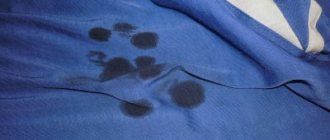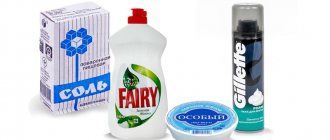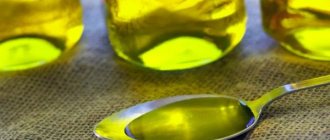The clothes of men who spend a lot of time in the garage often have not only an unpleasant pungent odor, but are also covered with a wide variety of stains. Most of the strong half of humanity practically live in their “second home”, and they are little concerned about how they look.
But their wives are puzzled by the question of how to wash diesel fuel, gasoline and other fuels and lubricants from clothes. Sometimes they cannot find a way to remove such complex contaminants as, for example, from diesel fuel.
Important: so that not a trace remains of the fuel stain, it is recommended to carry out cleaning measures immediately, without waiting for it to dry.
Is it possible to do without washing?
There are 3 options for removing technical odors from things without washing:
- Ventilation. Clothes are left outside (balcony) for several days or a week, depending on the size of the stain. If possible, hang it in a draft. Frosty air is especially good at eliminating the strong smell of gasoline.
- If hanging clothes outside is not possible, you need to cover the stain on all sides with newsprint. It will absorb both the greasy stain and the aroma. It is better to change the newspaper periodically. After several days, when the smell noticeably decreases or disappears, clothes should be hung up for airing, at least in the apartment.
- You can remove the persistent smell of gasoline without ventilating or washing clothes. To do this, rub the stain thoroughly with washing powder, leave for a few minutes, and then rinse. You need to put a rag on this place and iron it with a maximally heated iron (depending on the type of fabric) until the stain is completely dry.
Gasoline, in principle, does not wash well, so even when using the washing method, you should first use one of the indicated methods. This will significantly increase the chances of saving the clothes.
Machine washing of fabrics from gasoline stains must be preceded by preliminary soaking in a solution of water with detergents or other household cleaning products:
- How to remove the smell of gasoline from clothes with washing powder? The problem area is treated with a “mush” of the product. Leave for 30.0-40.0 minutes. After this time, the item of clothing is washed in warm water with a solution of the same powder, and then machine washed.
- How to remove gasoline stains with dishwashing detergent? Instead of a “mush” of washing powder, detergent is used, but further measures correspond to the previously indicated instructions.
- How to remove a stain with soda? Prepare a solution in the following proportion: 4.0 tablespoons of soda per glass of warm water. Treat the stain, leave for up to 40.0 minutes, rinse, and machine wash.
- How to remove a gasoline stain with a mixture of starch, turpentine, and ammonia? The mixture is made up in the following proportions: 1.0 teaspoon/3.0 drops/3.0 drops. It should be rubbed into the problem area with a short-bristled brush. The rest of the steps are obvious.
- How to remove fuel stains with mustard powder? Mustard solution successfully removes odor. The disadvantage is represented by the duration of soaking - from 2.0 to 4.0 hours.
- You can remove gasoline stains with citric acid. Dosed application will quickly eliminate the smell of gasoline from clothes and prepare clothes for the main wash. However, consequences may occur in the form of changes in the color and texture of the fabric.
Why does an unpleasant odor linger on fabric for a long time?
Gasoline is an oily substance; when it comes into contact with any material, it is quickly absorbed, penetrating deeply into the structure of the fabric. As volatile fuel vapors evaporate, they emit a specific odor. It's quite difficult to get it out.
In the first days, the concentration of substances on the fabric fibers is high, and therefore the aroma is strong. By hanging a soiled item on the balcony for a day, you can get rid of the unpleasant odor.
What to do if gasoline gets on your clothes
First of all, the scale of the problem is assessed. Further actions to bring the item into proper form depend on the volume. If the gasoline stain is small, then it is enough to carry out local measures, but if there are significant traces of gasoline on clothing, a fundamental approach will be required. So, how to wash clothes in gasoline, and what to do first:
- It is necessary to remove soiled clothing. If it is impossible to clean on site, to eliminate some of the odor, you need to ventilate the item in a draft or open area. Then pack it in a bag and deliver it home.
- You should not get into a car wearing clothes with fresh stains from fuel and lubricants - the interior will be dirty, and the smell will persist for a long time. If such a need exists, you need to take preventive measures, for example, use a cushion made of waterproof material on the seat and drive with the windows slightly open (when the air conditioner is on, the smell will take hold in the cabin filter).
- The decision to clean the stain in the washing machine without first preparing the clothes will lead to the fact that subsequent washing of other items will be accompanied by the smell of gasoline.
- To avoid poisoning, do not use chlorine-containing cleaners. Benzenes in interaction with chlorine cause a chemical reaction with the active release of substances harmful to humans.
If your washing machine smells
How to remove the smell of gasoline from a washing machine if it is soaked through with it? Some housewives are sure that nothing can be done about it, but in fact there are ways to eliminate the aroma.
The most common means of removing petroleum odors from a washing machine is baking soda . Just pour 200 grams of soda into the powder compartment and run any wash cycle with a temperature below 30 degrees. Temperature is very important, because if the water is hot, the smell of gasoline will only intensify. There is no need to load things into the car.
Effective ways to deal with fresh stains
- Since it is difficult to wash gasoline from clothes without preliminary preparation, the stain must be treated. To do this, mix one spoon of starch and two drops each of ammonia and turpentine. Using a toothbrush, apply the resulting mixture to the stained area, but rub in without enthusiasm so as not to spoil the item. Next, the treated area needs to be rinsed and after that the clothes will be ready for washing.
- The second method, which tells how to remove the smell of gasoline, is somewhat simpler, but it is only suitable for contaminated small areas. Stains should be diligently wiped with regular laundry soap, then rinsed and washed with an increased amount of washing powder.
- At home, you can make a solution, after using which the gasoline is washed off instantly. Vinegar, boron and soda are mixed in equal proportions and applied to the area of contamination. After 25 minutes, the clothes must be washed and rinsed with special care (if the solution is exposed to the fabric for a long time, the solution will change its color).
- Without preliminary preparation, the persistent smell of gasoline will never be washed off from things the first time. Therefore, before washing, you can use a solution of concentrated soda, which you need to treat the stain and leave for half an hour, then rinse and wash.
- Ammonia perfectly removes the smell of ingrained gasoline from clothes. It must be applied to the stained area and rubbed a little. The most convenient way to apply ammonia is with a spray gun. This way it will immediately penetrate deep into the stain and remove the unpleasant aroma from the inside. After this, the item should be left for 15 minutes and then rinsed.
- Never wash out the persistent smell of gasoline in the washing machine.
It will absorb the water and be transferred to the drum. And it is more difficult to remove unpleasant odors from a washing machine than from clothes. To get rid of odor, hand wash in cool water. If the stain has not been treated with anything beforehand, you need to add more washing powder to the water than usual. It would also be a good idea to add lemon juice or glass cleaner. After washing, items are rinsed in water with fabric softener. It also needs to be added more than usual. - To remove the smell from a fresh stain, you need to quickly wash clothes that smell of gasoline in water with added detergent. Highly foaming products are suitable for this.
Removing diesel and gasoline stains from colored and white clothes is one of the main tasks that many families face. This is due to the rapid growth in the number of vehicles coupled with the need to solve problems that arise during operation.
The sooner proper washing of items (T-shirt, trousers, shirt) begins, the easier it will be to remove traces of fuel. To save a stained product, you must immediately sprinkle it with salt and rub it in a circle, but without smearing the dirt.
When it is a terry towel or a woolen sweater, leave the treated item for one hour. After the specified time has passed, place in the machine and wash with powder and gel. The effect will be noticeable immediately; salt is an excellent absorbent.
Diesel stain on jeans
The best means for removing traces of diesel fuel and gasoline:
- Detergent. When it is not possible to manipulate salt, dish gel will help remove the stain. Detergent is applied to the surface of the product, foamed, and left for 15 minutes. Then it is recommended to wash on a suitable cycle. A special conditioner that is added during washing will help get rid of the pungent odor.
- Soda detergent laundry soap. The proposed folk method will help remove diesel fuel from clothes. Mix all the ingredients in equal proportions, make small shavings from the soap, you get a homogeneous mass. Take 3 tablespoons of the mixture, dilute it in three liters of water, pour over dirty clothes and leave for half an hour. Rinse with running water, immerse in the drum of the machine, add powder, set the appropriate mode.
- Laundry soap. A cheap remedy saved a huge number of damaged things. Thanks to the correct use of soap, it is possible to clean dirt of any origin. Soak the product with warm water, lather traces of gasoline and diesel fuel with laundry soap, you should get a thick layer. Leave for four hours. If the dirt is too large, a concentrated soap solution will do. Grate half the block and dilute with two liters of warm water. Soak the laundry in the resulting liquid for four hours, then wash thoroughly by hand, paying attention to dirt. Each spot is treated with a special brush using rhythmic, active movements. Rinse with clean water. Dry in fresh air to remove the smell. The proposed recipe can be used for colored items.
- Automotive paste. Every car owner must have a cleaning paste. The method of application is very simple: apply the indicated product to the area of contamination, leave for 15 minutes. Rinse and machine wash.
- Butter and lemon. An effective, affordable and budget-friendly method is a mixture of vegetable oil and lemon juice. The components are mixed in equal proportions and rubbed into the contaminated area. After ten minutes, you can rinse the item and wash it with powder. This is an ideal product if you need to wash items made from rough fabrics, jackets, jeans.
- Ammonia. Ammonia will help to wash white clothes from diesel fuel. Dissolve 20 ml of alcohol in two hundred milliliters of water, moisten the swab, and then treat the dirty area. It is advisable to wipe until it completely disappears. With active friction it will take about 2-3 minutes.
The best means for removing traces of diesel fuel
The noted methods are not final, but many people use them, achieving a positive result.
Cleaning leather products
Leather clothing, like any other item of clothing, is susceptible to contamination. Troubles also happen to her in the form of gasoline stains. But we must take into account that not all means for eliminating unpleasant odors can be used to clean this material. The right choice in this case is laundry soap. It needs to be grated and dissolved in a small amount of water, then use a cotton swab to rub the soap solution into the area of the stain, and then thoroughly wipe the surface with a dry cloth.
Help from specialists
There are many ways to restore a fresh scent to clothes at home, but there are situations when even the strongest of them are powerless. If, despite all efforts, the smell of gasoline cannot be removed with anything, or there is no time to independently treat the stains, then you should turn to professionals and take the item to the dry cleaner. Industrial products used by specialists can cope with even the most serious stains and return a piece of clothing to its original appearance. The main thing is that the receiver makes a note on the receipt that not only the fabric needs to be cleaned, but also the removal of petroleum odor.
In fact, only in rare cases is the contamination so severe that the item cannot be cleaned. Basically, traces of gasoline, as well as an unpleasant odor, can be removed at home using improvised means. The main thing is to be patient and not to get upset if the problem is not completely eliminated the first time. All you have to do is show a little persistence, and then the clothes will once again exude the aroma of freshness.
Rate this post
Local stain cleaning
Proven folk methods, improvised means and household chemicals will help remove old stains. It is better to remove contaminants from gasoline and diesel fuel immediately, otherwise the liquid will be absorbed into the fabric and fixed in it.
The best remedies for old stains:
- Petrol. When the marks have dried and become embedded in the material, it is recommended to use household gasoline, but not automobile gasoline. As for household products, they have a high degree of purification. It is sold in all hardware stores. Take a piece of cloth, soak it in gasoline and wipe off the mark. The direction of movement is towards the center from the edges, so as not to increase the area of contamination. To manipulate, you will have to change the flap several times. Continue rubbing until the dirt comes off. After this, rinse with water and machine wash.
- Stain remover. Wash overalls, jeans or a shirt with old stains in powder, rub traces of diesel fuel by hand. Dilute two caps of a good quality stain remover in three liters of water. Soak the items for thirty minutes, rinse and wash with powder.
- Paper. A hot iron and white paper will help remove stubborn greasy marks. Wash and dry the product. Place paper on both sides of the dirty area and iron it with a medium-heat iron. After performing the heat treatment, an oily imprint will appear on the surface of the paper. Replace the paper and continue ironing until the dirt comes off.
Professional stain remover
By following the recommendations, you can remove traces of gasoline, diesel fuel, and also overcome the bad smell.
A powerful way to combat the smell of diesel fuel is to ventilate in the open air. Given the fact that this substance is volatile, the vapors disappear within two weeks. As for dirt, it is very easy to remove grease.
Top 4 effective ways:
- Washing powder. Soiled clothes will become fresh and clean again if you wash them using powders such as Tide and Ariel. You should not use a washing machine; hand washing in a basin works best. Hang the product in the fresh air, dry, and ventilate.
- Dishwashing gel. The fight against traces of diesel fuel and gasoline at home will be crowned with success if you use regular dishwashing liquid. Dissolve 3 tablespoons of gel in a bowl of warm water, shake with your hands, foam will appear. Immerse clothes or a towel in the soapy solution, leave for an hour, then wash by hand.
- Starch. The essence of the technique is that a special active mixture is used, where the base ingredient is potato starch. Recipe: thoroughly mix a few drops of ammonia, turpentine, adding one teaspoon of starch. An old toothbrush will come in handy; you should use it to apply the paste to dirty areas, rubbing in smooth, soft, gentle movements. Leave for two hours, wash with powder.
- Heat treatment. The specificity of the technology is to use a hot iron, spending a minimum amount of effort and time. Algorithm of action: wash the oily mark with powder, place a rag underneath, iron the item with a heated iron. Having completed the manipulation, you will be able to make sure that all the smell is gone and the stain has disappeared. It is important to remember that this option cannot be used for delicate products.
Stain removal products
If small areas of stains are detected, use one of the following methods:
- If you have hand cleaning paste in your car or garage, it is recommended to rub a small amount of this detergent composition into problem areas of the fabric, and after 30.0-40.0 minutes, rinse with cold water,
- A commercially available ammonia solution, which is used to moisten the stained area, ventilate it and wipe it with a damp swab, will help you get rid of the smell quickly.
- mustard powder in a solution with water is suitable for local cleaning (as in the previous option), as well as for processing a single piece of clothing,
- a solution based on laundry soap will remove the smell from leather items, but after using it, it is enough to wipe the application area with a damp cloth, and you can dry it with a dry rag.
Recommendations from experts
First of all, you need to pay special attention to methods that under no circumstances should be used to get rid of the smell of fuel for vehicles.
This categorical approach is due to the fact that these types of fuel have an extremely pungent and persistent odor.
In order to avoid unnecessary problems, it is best to remove diesel stains by hand washing - in a basin.
In an effort to get rid of odor, you should also not resort to using bleach. This prohibition is due to the bleach content in this product: this component provokes a reaction, which results in the formation of harmful fumes.
When struggling to keep your clothes perfectly clean, you need to be prepared for the fact that they cannot be restored after the first wash.
To achieve the desired results, you need to be patient and repeat this procedure several times.
As practice shows, this approach allows you to completely get rid of the smell and enjoy the look of clean and fresh clothes.
In between washes, the soiled item must be thoroughly ventilated.
What not to do
When removing gasoline stains from things, under no circumstances should you:
- Machine wash the item. The drum will absorb the aroma, and subsequently, after each wash, things will release a little to them.
- Use bleach or bleach containing this element. Bleach will react with gasoline and completely ruin the item.
Also, you should not do the following:
- Wash the stain without prior preparation. It is advisable to treat it in advance or dry it in the fresh air.
- Use hot water for washing. Cold or slightly warm water is used to remove unpleasant odors.
Diesel fuel: two sides of the same coin
Today, a car is associated, first of all, with the ability to get to work quickly and without hassle, to spend vacation time pleasantly and comfortably, etc. However, a natural consequence of this undoubted advantage is the pungent odor that remains on this or that thing.
To remove it from a thing with minimal effort and money, it is recommended to be extremely careful - to begin eliminating the problem immediately when it forms.
Delay leads not only to the aggravation of the problem, but also to the emergence of a risk: the fact is that a stain of diesel fuel or gasoline on clothing gives the fabric such a property as flammability.
After you have managed to remove the pungent odor from the item, it must be washed using a certain technology.
Special means
Don’t know how to wash gasoline from clothes using improvised means? It couldn't be easier. The first folk recipe that will come to the rescue is dishwashing liquid, which must be applied to the stained area or soaked in water with the addition of a product. We recommend using a good quality composition that can quickly cope with contamination.
Soak the item of clothing for a couple of hours, then wash in high temperature water with the addition of washing powder. Machine wash is also a good option. The method is extremely effective if the contamination is treated immediately after detection - after drying, it is quite difficult to clean gasoline traces.
Another recipe involves using chalk. Crush a small amount of chalk and pour it onto the contaminated area, leaving it for a couple of hours. Then shake the chalk off your clothes. If the remedy turns out to be ineffective, the procedure can be repeated a couple of times. If you don't have chalk on hand, use table salt.
After cleaning, wash the item of clothing as usual. To combat dirt, it is good to use a special soap called “Antipyatin”, which can easily be found in the store on the shelf with household chemicals. Simply lather any petrol traces you find, leave for a while, then wash the product.
To get rid of the stain, clothes must be washed after using special products.
If you do not have free time and (or) the opportunity to cope with the task yourself, you can always use the services of dry cleaners. For a fairly modest fee, they can quickly and without consequences eliminate both unpleasant and greasy stains. This is especially true if you spilled liquid on a product made of genuine leather, which is very susceptible to chemical reagents.
How to remove odor from hands
Every car enthusiast has encountered a problem after repairs - their hands smell strongly of gasoline, and ordinary soap or powder cannot cope with this smell.
You can remove the aroma of petroleum products from your hands using glass cleaner ; you just need to rinse your hands a little with it and then wash them under running water.
If you don’t have such a remedy on hand, you can use lemon juice; it also works well against strong odors.
There are also specialized products that are sold in car supply stores.
Odorous mixture
- Measure out equal parts of potato starch, ammonia and turpentine.
- Mix the ingredients carefully.
- Apply the mixture to the contaminated area and scrub with a brush. It is recommended to take an unnecessary toothbrush.
- Wash with regular powder
- Evaluate the effectiveness of cleaning and, if necessary, clean with the mixture again to remove the stains completely.
- Yellowish traces remaining after treatment are removed with a weak solution of hydrogen peroxide.
Potato starch with ammonia and turpentine is applied to the stain
Lemon: juice or acid
- Apply a little lemon juice or citric acid solution to the contaminated area.
- Wash the item.
- Repeat treatment if necessary.
Before use, drip lemon juice onto an inconspicuous area. Make sure that the paint on the product is durable, as citric acid tends to bleach the fabric.
Lemon and citric acid will remove gasoline and whiten fabric.
Heat treatment
This is the least expensive method, but it will require a well-heated iron and ironing board. Heat treatment can be carried out on a flat surface that is resistant to high temperatures.
- Wash the stained area of clothing by hand with laundry detergent.
- Place any clean fabric on the ironing board.
- Place the contaminated item on top.
- Iron the problem area with a hot iron until the gasoline evaporates. The stain should disappear after this treatment.
Exposure to high temperatures will cause the gasoline stain to evaporate.











